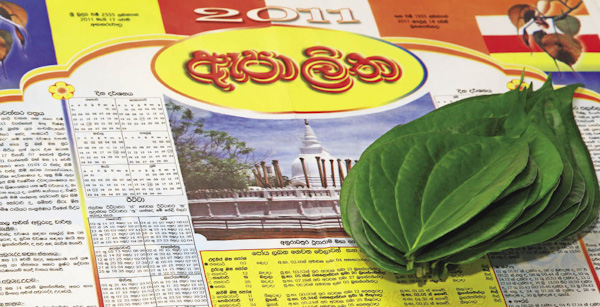
The litha is the document that is consulted whenever customs are performed, whether at New Year or any other time throughout the year. It’s use provides an organised framework for the conducting of customs.
Words Chiranthi Rajapakse
“Miniththuwen enawa” (I’ll be there in a minute”) Sounds familiar? Anyone who has kept an appointment in Sri Lanka will know that phrase. Sri Lanka is an easygoing nation when it comes to timing, indeed being too punctual can even be considered a little strange. But there are certain occasions where timing is of vital importance. Many important events are conducted at astrologically determined auspicious times where delays would be out of the question.
This is especially true in the month of April when the Sinhala and Tamil New Year (Avurudu) Festival is celebrated. New Year customs such as partaking of the first meal and departing for work are all performed according to carefully observed auspicious times. But how do households all over the island keep track of the auspicious times at which to observe these rituals? This is where the ‘litha’ (New Year almanac) comes into its own. This is the document, rather like a calendar, which is found displayed on the wall in most households. It lists out the auspicious times decided by astrologers for observances of New Year rituals, as well as other auspicious times and information relating to customs throughout the year.
The use of a printed litha in Sri Lanka started in the nineteenth century explains Professor H M D R Herath, of the Department of Sociology, Faculty of Arts, University of Peradeniya. The main change brought about by the litha was the provision of a systemic framework for the performance of customs. “It imposed discipline and brought a unity to the mainly agricultural community which celebrated the New Year,” says Prof Herath.
The time of the New Year as given in the litha, is determined by astrologers, and is marked by the entry of the sun after its yearly cycle through the 12 signs of the zodiac from Pisces, the last, to Aries the first. The ending of the old year and the beginning of the new year occur several hours apart. The time between the end of the old year and the dawn of the new year is called the nonagathaya – neketh nee, literally, the time when there are no neketh (auspicious times). During this time, people are traditionally encouraged to refrain from regular pursuits and restrict themselves to religious observances.
Prominently displayed on the litha are the auspicious times for the undertaking of customs with the dawn of the New Year. These include the lighting of the hearth for the preparation of the first meal, conducting of the first transactions between family members, (ganudenu), partaking of the first meal, annointing of oil and departing for work.
A quick perusal of a litha will show how its use is not limited just to Avurudu time. It displays the Poya days for the year and the auspicious times at which to observe sil. It also lists out auspicious times throughout the year for activities. Prof Herath explains that specially among the agricultural community, the litha is a vital document which provides a guide for life throughout the year. It is consulted when making any important decision; from deciding on a favourable time to undertake a journey to deciding whether a particular day is suitable for moving into a new house. The litha also displays the ‘rahu kalaya’ or inauspicious times of the day at which activities should not be undertaken. These are widely used, and many people do not undertake important activities such as business transactions at these times.
The litha also reflects cultural beliefs that have become a part of peoples’ lives. One such concept is the belief that a gecko falling on a person’s body can have various good or bad consequences and one section of the litha describes this in detail. For example, it is believed that the falling of a gecko on a person’s left ear will result in the person making profits at business activities while falling on the right ear will result in long life. Through its recording of popular cultural beliefs, the litha is also valuable as a sociological document.
In spite of the changes in lifestyle brought about by urbanisation, traditional customs such as the observance of auspicious times, still exert a strong hold over the lives of most Sri Lankans. This is perhaps most apparent during the time of the New Year. For a few days, even in the normally busy urban city of Colombo, businesses stop, shops close and roads become deserted because everyone has ‘gone home’ for the new year. To meet family, observe traditional customs and eat those delicious sweetments, but of course, all at the correct appointed time.


